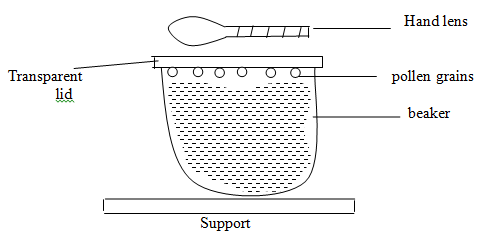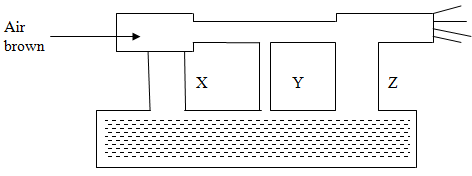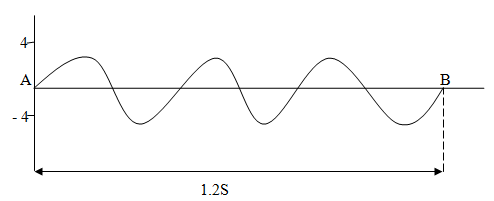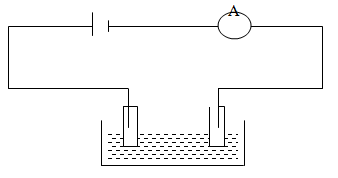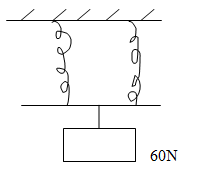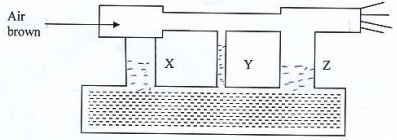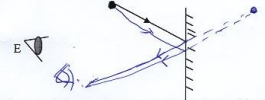SECTION A(20 MARKS)
- Convert 4.034g/cm3 into kg/m3 (1mk)
- Define the term “accuracy” and state the accuracy of a metre rule. (2mks)
- A form one student was attempting an experiment when he got electrocuted. State the first aid measure that should be carried out to help him. (1mk)
- .Water flows steadily along a horizontal pipe at a volume rate of 8.0 x 10-3m3/s. if the cross section area of the pipe is 20cm2, calculate the velocity of the fluid. (2mks)
- A boy standing in front of a cliff blows whistle and hears the echo after 0.55. He then moves 17metres away from the cliff and blows the whistle again. He now hears the echo after 0.65. Determine the speed of the sound. (3mks)
- The circuit below shows lamps in parallel. Indicate on the diagram where you would put a switch to control both lamps together. (1mk)
- A student observed her face in a concave mirror of focal length 100cm. if the mirror is 80cm away, find the image distance and state two characteristics of the image formed. (3mks)
- State two factors that affect the speed of sound in air. (2mks)
- The figure below shows a conductor carrying current placed in the magnetic field of two magnets. Complete the diagram by showing the field pattern and the diagram of force F that acts on the conductor. (1mk)
- A student observed some pollen grains on the surface of water in a beaker with a help of hand lens as shown in the figure.
- State the observation made. (1mk)
- Explain the observation in (a) above. (1mk)
- What conclusion can be drawn from the above experiment. (1mk)
SECTION B
-
- Explain the meaning of
- Streamline flow. (1mk)
- Turbulent flow. (1mk)
- State three assumptions when deriving the equation of continuity. (3mks)
- Water flows along a horizontal pipe of cross sectional area 30cm2. The speed of water is 4m/s but it reaches 7.5m/s in a constriction in the pipe. Calculate the area of the constriction. (3mks)
- It is dangerous to stand too close to a railway line on which a fast moving train is passing. Explain. (2mks)
- Two table tennis balls are in the same level while suspended from threads a short distance apart. A stream of air is blown between the balls in a horizontal direction. Explain what happens to the balls. (2mks)
- The figure 12 represents a tube through which liquid is flowing in the direction shown by the arrow. The vertical tubes have oval cross- sectional area,
Show on the figure the relative positions of the level of the liquids in section marked X, Y and Z. (1mk)
- Explain the meaning of
-
- State the difference between mechanical wave and electromagnetic wave (2mks)
- The sketch is a displacement time graph of a wave travelling at 320m/s. the waves takes 1.2 seconds to move from point A to B
Find the- amplitudes. (1mk)
- Frequency (3mks)
- The wavelength (2mks)
-
- Explain the term “pulse” as used in waves (1mk)
- Calculate the wavelength of the KBC fm ratio waves transmitted at a frequency of 95.6 mega Hertz (V=3.0 x 108m/s ) (3mks)
- The diagram below shows a series circuit.
- A current of 2x10-3A flows around the circuit.
- State the sub-atomic particles responsible for the flow of current (1mk)
- How much charge passes through the liquid in 3 minutes (2mks)
- The capacity of an accumulator is 120Ah. What does this mean (1mk)
- Polarization is a defect in a simple coil. Explain the meaning of polarization and suggest how you would minimize its effect in the cell (2mks)
- A current of 2x10-3A flows around the circuit.
-
- State hooke’s law (1mk)
- It is easier to bend an iron rod than a glass rod of the same dimensions at the same ………………. Explain this. (1mk)
- State two factors that govern the strength of a spring of a given material (2mks)
- Two identical spring of each spring constant 5.0 N/cm are used to support 60N as shown below
Determine the total extension of the system (3mks)
-
- The diagram below shows two bar magnets X and Y and the magnetic pattern.
Identify B and C (1mk) - State with a reason which magnet X or Y is stronger (2mks)
- State two way magnetizing a magnetic material (2mks)
- The diagram below shows two bar magnets X and Y and the magnetic pattern.
- The figure below shows a point object O placed in front of a place mirror.
- On the same Diagram, draw a ray to locate the position of the image I as seen from the eye E (2mks)
- Explain what is meant by a virtual image (1mk)
- An object of height 10cm is placed 5cm in front of concave mirror of focal length 3cm. determine position, name and size of the image by scale drawing (3mks)
- Show the magnification of a convex mirror is given by m = v/f -1 (3mks)

MARKING SCHEME
SECTION A(20 MARKS)
- Convert 4.034g/cm3 into kg/m3 (1mk)
- 4.034g/cm3 × 1000 = 4034kg/m3
- Define the term “accuracy” and state the accuracy of a metre rule. (2mks)
- Is the smallest unit an instrument can measure accuracy of metre rule is 1 d.p or 0.1cm
- A form one student was attempting an experiment when he got electrocuted. State the first aid measure that should be carried out to help him. (1mk)
- Turn off the current at the main switch.
- Using a non-conducting object such as wooden rod to move the victim away from the object.
- .Water flows steadily along a horizontal pipe at a volume rate of 8.0 x 10-3m3/s. if the cross section area of the pipe is 20cm2, calculate the velocity of the fluid. (2mks)
Volume rate = A × velocity
Velocity = volume rate
area
8.0 x 10-3m3/s = 4m/s
2 × 10-3 m2 - A boy standing in front of a cliff blows whistle and hears the echo after 0.55. He then moves 17metres away from the cliff and blows the whistle again. He now hears the echo after 0.65. Determine the speed of the sound. (3mks)
V = 2d/t
2(17+x) = 2x
0.65 0.55
0.55(34+2x) = 13x
18.7 = 1.3x − 1.1x
x = 93.5
v = 93.5
0.55
= 340m/s - The circuit below shows lamps in parallel. Indicate on the diagram where you would put a switch to control both lamps together. (1mk)
S - A student observed her face in a concave mirror of focal length 100cm. if the mirror is 80cm away, find the image distance and state two characteristics of the image formed. (3mks)
1/f = 1/u + 1/v
1/100 = 1/80 + 1/v
1/v = 1/100 − 1/80
1/v = −1/400
= − 400cm
- virtual
- magnified
- upright
- State two factors that affect the speed of sound in air. (2mks)
- Temperature
- Humidity
- Direction of the wind
- The figure below shows a conductor carrying current placed in the magnetic field of two magnets. Complete the diagram by showing the field pattern and the diagram of force F that acts on the conductor. (1mk)
- A student observed some pollen grains on the surface of water in a beaker with a help of hand lens as shown in the figure.
- State the observation made. (1mk)
- It is observed that the pollen grains are in constant random motion
- Explain the observation in (a) above. (1mk)
- The grain are being hit continually by the movement of small invisible particles of water
- What conclusion can be drawn from the above experiment. (1mk)
- Matter is made up of tiny small particles which are in constant random motion
- State the observation made. (1mk)
SECTION B
-
- Explain the meaning of
- Streamline flow. (1mk)
- It is a flow in which at any given point each and every particles of the fluid travel in the same direction and with same velocity
- Turbulent flow. (1mk)
- It is a flow in which the speed and direction of the fluid particles passing at any given point vary with time.
- Streamline flow. (1mk)
- State three assumptions when deriving the equation of continuity. (3mks)
- The fluid is flowing steadily
- The fluid is incompressible
- The fluid is non-viscous
- Water flows along a horizontal pipe of cross sectional area 30cm2. The speed of water is 4m/s but it reaches 7.5m/s in a constriction in the pipe. Calculate the area of the constriction. (3mks)
A1V1 = A2V2
A2 = 30 × 4 = 16m/s
7.5 - It is dangerous to stand too close to a railway line on which a fast moving train is passing. Explain. (2mks)
- You can be trapped into the moving rail, because high speed creates a low pressure, high pressure pushes the person into the vehicle.
- Two table tennis balls are in the same level while suspended from threads a short distance apart. A stream of air is blown between the balls in a horizontal direction. Explain what happens to the balls. (2mks)
- The balls come together, high speed of air reduces pressure between them. Higher pressure on the other side pushes them together.
- The figure 12 represents a tube through which liquid is flowing in the direction shown by the arrow. The vertical tubes have oval cross- sectional area,
Show on the figure the relative positions of the level of the liquids in section marked X, Y and Z. (1mk)
- Explain the meaning of
-
- State the difference between mechanical wave and electromagnetic wave (2mks)
- Mechanical wave require material medium for transmission while electromagnet do not require material medium transmission
- The sketch is a displacement time graph of a wave travelling at 320m/s. the waves takes 1.2 seconds to move from point A to B
Find the- amplitudes. (1mk)
- 4cm
- Frequency (3mks)
T = 1.2/3 = 0.45
F = 1/T = 1/0.4 = 2.5HZ - The wavelength (2mks)
V = λF
λ = V/F
= 320m/s
2.5HZ
= 128m
- amplitudes. (1mk)
-
- Explain the term “pulse” as used in waves (1mk)
- V = λF
A pulse is generated when a single vibration is sent through the medium.
- V = λF
- Calculate the wavelength of the KBC fm ratio waves transmitted at a frequency of 95.6 mega Hertz (V=3.0 x 108m/s ) (3mks)
V = λF
λ = V/F
= 3.0 × 108 = 3.1m
9.56 × 107
- Explain the term “pulse” as used in waves (1mk)
- State the difference between mechanical wave and electromagnetic wave (2mks)
- The diagram below shows a series circuit.
- A current of 2x10-3A flows around the circuit.
- State the sub-atomic particles responsible for the flow of current (1mk)
- Protons
- Electrons
- How much charge passes through the liquid in 3 minutes (2mks)
Q = It
= 2 × 10−3 × 3 × 60 = 0.36C
- State the sub-atomic particles responsible for the flow of current (1mk)
- The capacity of an accumulator is 120Ah. What does this mean (1mk)
- 120A can be drawn in an accumulator in one hour
- Polarization is a defect in a simple coil. Explain the meaning of polarization and suggest how you would minimize its effect in the cell (2mks)
- Is the formation of hydrogen bubbles around the copper plate. It is minimized by use of a repolarizer such as manganese (v) oxide.
- A current of 2x10-3A flows around the circuit.
-
- State hooke’s law (1mk)
- For a helical spring or other elastic material, the extension is directly proportional to the stretching force provided elastic limit is not exceeded.
- It is easier to bend an iron rod than a glass rod of the same dimensions at the same ………………. Explain this. (1mk)
- Is because of brittle material of glass.
- State two factors that govern the strength of a spring of a given material (2mks)
- Diameter of the spring
- Number of turns
- Length of a string
- Two identical spring of each spring constant 5.0 N/cm are used to support 60N as shown below
Determine the total extension of the system (3mks)
kp = nk1
5 × 2
= 10 N/cm
E = F/ks
= 60Ncm
10N/cm
= 6cm
- State hooke’s law (1mk)
-
- The diagram below shows two bar magnets X and Y and the magnetic pattern.
Identify B and C (1mk)- B - North pole
- C - North pole
- State with a reason which magnet X or Y is stronger (2mks)
- X is stronger because magnetic field lines are close compared to that of Y
- State two way magnetizing a magnetic material (2mks)
- Stroking method in North-South direction
- Hammering method in North- South direction
- Electrical method using DC current
- The diagram below shows two bar magnets X and Y and the magnetic pattern.
- The figure below shows a point object O placed in front of a place mirror.
- On the same Diagram, draw a ray to locate the position of the image I as seen from the eye E (2mks)
- Explain what is meant by a virtual image (1mk)
- The image that cannot be formed on the screen.
- An object of height 10cm is placed 5cm in front of concave mirror of focal length 3cm. determine position, name and size of the image by scale drawing (3mks)
- Show the magnification of a convex mirror is given by m = v/f -1 (3mks)
1/f × v = 1/v × v + 1/u × v
v/i = 1 + v/u
v/f = 1 + m
m = v/f − 1
Join our whatsapp group for latest updates
Tap Here to Download for 50/-
Get on WhatsApp for 50/-
Download Physics Questions and Answers - Form 3 Term 1 Opener Exams 2023.
Tap Here to Download for 50/-
Get on WhatsApp for 50/-
Why download?
- ✔ To read offline at any time.
- ✔ To Print at your convenience
- ✔ Share Easily with Friends / Students



